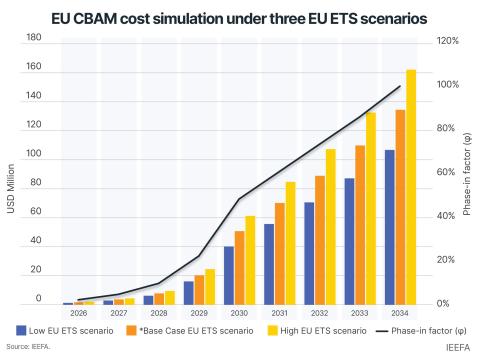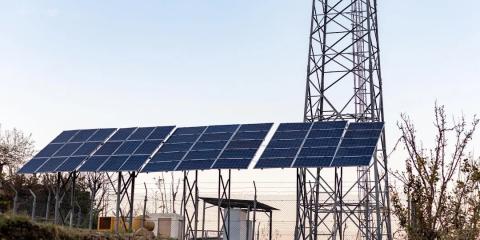IEEFA Comments: Environmental assessment for proposed Louisiana LNG project
Download Full Report
View Press Release

Key Findings
IEEFA comments to the Federal Energy Regulatory Commission about omissions in an analysis of a proposed Louisiana LNG project raise questions about its potential
The Venture Global Plaquemines LNG Uprate Amendment Project, which would increase production at the liquefaction facility by 3.2 million tons per annum, may occur at a time when the LNG market begins slowing
IEEFA found that FERC’s analysis of the Louisiana LNG project failed to evaluate the risk of increased methane emissions; the effects of improved methane controls on LNG supply; and the potential pollution effects of transporting the LNG across oceans
Executive Summary
The Institute for Energy Economics and Financial Analysis (IEEFA), a nonprofit organization focused on research and analysis of global energy markets and trends, provides the following comments in response to the Notice of Availability of the Environmental Assessment (EA) for the Proposed Venture Global Plaquemines LNG Uprate Amendment Project, docket number CP22-92-000. These comments are intended to address omitted or incorrect information that the applicant should provide to allow the Federal Energy Regulatory Commission (FERC) to properly evaluate fundamental economic assumptions behind the project and its environmental effects.
The proposed amendment by Plaquemines LNG requests an uprate in peak liquefaction capacity to 27.2 million metric tons per annum (MTPA), a 3.2 MTPA increase over the previously approved amount. Although the applicant’s request for additional throughput does not propose changes to the design of the terminal, FERC needs to conduct a more rigorous analysis of both the rationale and the potential effects.
The EA conclusion by FERC staff, issued Jan. 13, 2023, that the uprate “would not constitute a major federal action significantly affecting the quality of the human environment,” appears deficient in the consideration of three areas: Potential changes in the LNG market; methane emissions; and emissions from propulsion systems. Neither propulsion systems nor methane emissions were explicitly mentioned in the recently issued EA. The Final Environmental Impact Statement from May 2019 that provides the foundation for the EA also excludes mention of propulsion systems.
The LNG Export Market May Be Significantly Weaker Than the Applicants Hope
Russia’s war on Ukraine and the resulting energy crisis in Europe affected global LNG import patterns. Before the war, global natural gas prices were dramatically lower, and developing economies in Asia were the predominant driver of LNG demand growth. Since the invasion, gas prices have spiked and LNG shipments to Europe have increased while imports to Asia have slowed.
The losses in Russian pipeline gas to Europe in 2022 prompted the spike in natural gas prices and the diversion of LNG shipments to Europe. The magnitude of the natural gas price surge reflected the premium Europe was willing to pay to secure volumes needed to offset its lost piped gas.
Europe’s benchmark Dutch Title Transfer Facility (TTF) traded at an average $39.07 per million British thermal units (MMBtu) in 2022. Natural gas prices for the Japan Korea Marker (JKM) in Asia and Henry Hub in the U.S. last year averaged $34.00 and $6.45 per MMBtu, respectively. The price disparity, about 15% higher on average in Europe compared to Asia, illustrates the profit impetus favoring the routing of more LNG shipments to Europe.
U.S. LNG exporters benefitted, shipping 52 million tons to the continent last year, more than double the 21.5 million tons imported by Europe in 2021. Globally, US exports grew by about 1 billion cubic feet per day to 81.2 million tons in 2022. Overall, Europe imported 124.9 million tons of LNG in 2022, up 59% from the 78.6 million tons imported during the previous year. Conversely, Asian LNG demand fell from 282 million tons (mt) in 2021 to 264 mt in 2022.
Developing nations in Asia felt the pinch of diverted supplies to Europe. Short-term demand responses to abnormally high spot LNG and natural gas prices included substitution (i.e., oil-fired generation, diesel generation, coal-fired generation, and nuclear), mandatory conservation, fewer spot LNG purchases, rolling blackouts, and higher utility bills for consumers. Key importing nations including China, Pakistan, Bangladesh, India, and Japan all imported less LNG in 2022 than 2021.
The LNG industry’s long-term growth prospects are not guaranteed. In fact, the demand responses to last year’s high prices have prompted energy forecasters—including Bloomberg, ICIS, and IEA—to all lower their projections for Asian LNG demand growth. These market developments may accelerate over the next several years if prices remain high, reducing the pace of long-term LNG demand growth in the very markets on which the global LNG industry has been relying on for projections of overall market growth.
Like Asia, Europe saw decreased gas consumption last year as a consequence of high prices and declining supplies of pipeline gas from Russia. Overall, natural gas consumption fell by 12% across the EU in 2022 due to slowing economic conditions exacerbated by their energy crisis, with demand declining as the year progressed. The continent faces continued declines in Russian gas shipments this year. The EU has responded to this reality with continued improvements in energy efficiency, a rapid increase in the deployment of renewables, an acceleration of the electrification of heat, and consumer behavior changes.
Even as demand growth assumptions may be faltering in both Europe and Asia, the global LNG industry is engaged in a major build-out of new LNG liquefaction capacity. Although global supply additions will be modest through the end of 2024, IEEFA expects 118 MTPA of new liquefaction capacity to come online between 2025 and 2027, with much of that new supply coming from projects in the U.S. and Qatar. In the context of several years of restrained global LNG demand growth and massive increase in supply coming online starting in 2025, the market case for additional LNG production from Plaquemines LNG is weaker than the applicants hope.
To summarize, energy security and geopolitical considerations have created the conditions for increased LNG imports into Europe over the short term. However, they have also spurred long-term measures to reduce overall European gas demand, both through political actions and through the market mechanisms by which consumers have adapted to the higher prices for natural gas and LNG. The focal point of these reactions is less demand for natural gas, not more. Meanwhile, high LNG prices and supply limits are reducing the pace of demand growth in Asia. Therefore, long-term assumptions should put more weight on the potential for slow growth in global market demand for LNG, and less emphasis on the flexibility that LNG imports provided over the short run. The profile for the fundamentals of the natural gas markets would have to look much different than they do today to justify the build-out that LNG exporters wish to fulfill. Additionally, sustained higher prices for LNG and natural gas are a precursor to stunted future demand for the commodity due to more changes in the market. Expectations set by the current environment for LNG may prove overly optimistic.
The EA Fails to Evaluate the Full Risk of Increased Methane Emissions from Increased Export.
The U.S. produces roughly 23 percent of the world’s natural gas. Methane is the main component of natural gas. The combination of these two statements suggests that the U.S. is responsible for a disproportionate amount of global methane emissions. Research has repeatedly shown that methane emissions from the U.S. oil and gas supply chain are far higher than figures reported by the industry to the U.S. Environmental Protection Agency (EPA), using EPA modeling methods to compute these estimates.,
The adverse environmental impacts from methane emissions are well documented. The need to understand the incremental increases of methane emissions from increased LNG shipping activities as part of the decision-making process is imperative to the objective of reducing methane emissions.
If Potential Export Markets Use Improved Methane Controls on Their Existing Sources of Gas, Demand for Gas Exported from the U.S. Could Be Reduced
Recent research by the Institute for Energy Economics and Financial Analysis (IEEFA), attached as an appendix to our comments, discusses the economic impact of greater deployment of innovative leak detection and repair (LDAR) technologies in relation to proposed new EPA rules. The research highlights how proved reserve estimates will increase as greater production leak mitigation takes hold.
The logic behind an improvement in reserves as new EPA methane emissions rules are implemented also applies to natural gas production and transport within the import nations. If the rest of the world follows suit and deploys measures to better mitigate methane emission in the oil and gas supply chain, then the world will have additional future supplies.
The extent to which mitigation efforts increase supplies has a follow-on effect on the demand for U.S. LNG exports. The bottom line is that the globe may not need as much future LNG export capacity because fewer leaks will occur.
Assumptions Regarding Potential Pollution Impacts of Marine Transport Are Oversimplified and Require More Analysis
Table 3 in the EA identifies seven pollutants and calculates the change in vessel operational emissions, assuming an increase from 310 to 356 vessels per year. The EA bases its evaluation of the increase in emissions on assumptions regarding an average vessel size, with the number of increased shipments made corresponding to the proposed increased capacity of the Plaquemines LNG terminal. Also, the calculation for the change in emissions was a proration of original emissions estimates over the proposed additional 46 vessels.
The conclusion that the change in the number of vessels exporting LNG from the Plaquemines LNG terminal will not have a significant impact, however, appears to rely on an oversimplified assumption regarding which vessels may provide shipping services.
LNG transport vessels can be distinguished by six separate types of propulsion systems. Also, numerous sizes of vessels carry LNG shipments. The EA notes that boil-off gas (BOG) occurring during loading operations is recovered at the marine berth and used by the facility as fuel. But the EA does not address the changes in BOG losses occurring at sea. The boil-off rate is dependent on tank surface area, the temperature outside the tank, the heat conductivity of the tank, and the extent to which the thermodynamic state of the LNG is being irritated by motion (i.e., rough or calm seas). The amount of BOG and emissions produced at sea will depend on the vessel carrying the LNG. A more thorough examination of likely shippers facilitating the additional trips is warranted.
Conclusion
The lack of discussion in the EA regarding shifting conditions in LNG demand, full evaluation of methane emissions, and the emissions impact of different propulsion systems for LNG transport highlight an incomplete analysis that could, if properly addressed, make a meaningful difference in emissions calculations and environmental impact. The global trajectory towards practices that can lower future methane emissions yields a conservation effect through which more natural gas is available because less has been wasted. This yield, combined with other major forces affecting the LNG global market, changes the future fundamentals of the project. We see a scenario on the horizon where natural gas prices and the need for LNG export terminals could decrease.
















